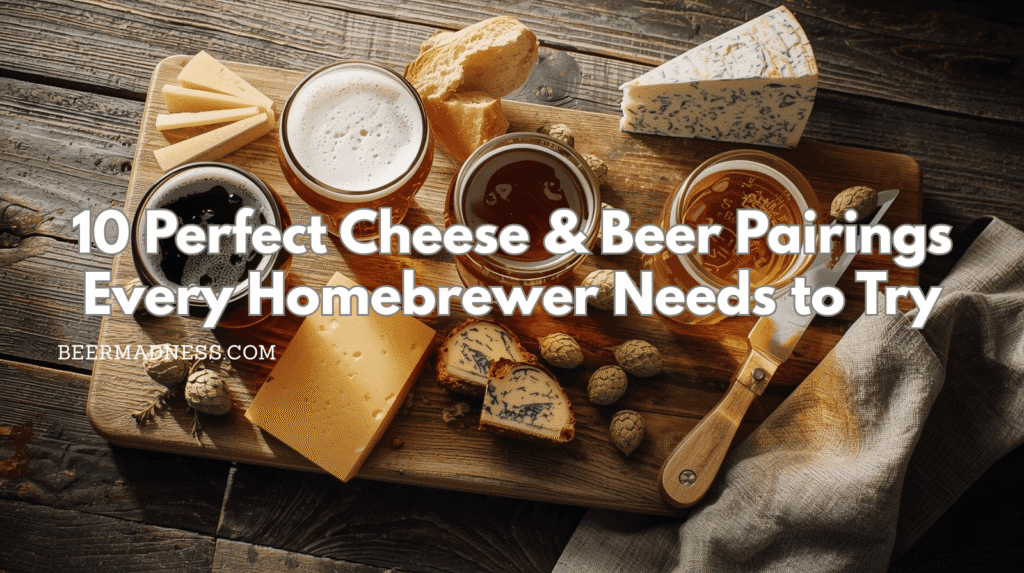Few things in life rival the simple pleasure of beer and cheese. Both are the result of centuries-old crafts — born from fermentation, patience, and the pursuit of balance. And while wine may often steal the spotlight in pairing conversations, the truth is that beer offers a far wider range of flavors, textures, and aromas that complement cheese in extraordinary ways.
In 2025, the world of 10 Perfect Cheese and Beer Pairings is more exciting than ever. From bright, citrusy IPAs that slice through the creaminess of cheddar to silky stouts that melt harmoniously into the salty funk of blue cheese, modern brewers and cheesemakers are rediscovering just how beautifully these two worlds collide.
Think of this as your ultimate homebrewer’s pairing guide — a roadmap to flavor harmony, whether you’re pouring your own latest batch or exploring new bottles from your favorite craft brewery.
For homebrewers, the connection runs even deeper. Both cheese and beer rely on controlled fermentation, temperature precision, and creative balance between sweetness, acidity, and bitterness. Understanding how malt sweetness softens a cheese’s tang, or how carbonation lifts its richness, can completely transform how you experience both.
The art of pairing has become so central to craft beer culture that even experts at the American Cheese Society and the Brewers Association now highlight collaborative tastings and pairing events across the US and Europe — proof that beer and cheese are no longer an unconventional duo, but a culinary match made in heaven.
So whether you’re a seasoned brewer or simply a curious taster, this 2025 guide will walk you through the science behind pairing, the framework for success, and ten must-try combinations that capture the heart of what makes beer and cheese so timeless together.
This post may contain affiliate links. If you click and purchase, I may receive a small commission at no extra cost to you. Learn more
The Science of Pairing: Why Beer and Cheese Belong Together
If you’ve ever wondered why beer and cheese taste so good together, the answer lies in chemistry — and a little bit of magic.

Beer and cheese pair perfectly because their shared fermentation roots and complementary flavor compounds — such as malt sweetness, lactic acidity, and umami richness — create balance. Beer’s carbonation cuts cheese’s fat, while malt and hops enhance its nutty, tangy, or creamy character.
Both beer and cheese are the result of ancient fermentation processes that transform simple ingredients into something far more complex. Cheese relies on bacterial cultures to develop acidity and aroma, while beer uses yeast to turn sugars into alcohol and CO₂. When you bring the two together, you’re effectively combining two living, evolving flavor systems that mirror each other’s depth.
According to the Brewers Association, this natural harmony explains why beer pairing events have grown exponentially in the past decade. Unlike wine, beer offers carbonation — a texture that cleanses the palate and resets your taste buds after every bite of cheese. That means you can enjoy rich triple-cream brie or sharp aged cheddar without overwhelming your senses.
1️⃣ The Chemistry of Contrast
At the core of every great pairing is contrast. The fat and salt in cheese soften the bite of hops, while beer’s bubbles lift its creamy weight.
For example:
- A malty amber ale adds sweetness to balance the tang of aged cheddar.
- A citrusy IPA sharpens a creamy goat cheese.
- A dry stout complements the salt and sharpness of blue cheese.
This chemical interplay — fat vs. acid, salt vs. sweetness — creates the perfect sensory balance.
2️⃣ The Magic of Texture and Temperature
Cheese’s richness begs for beer’s sparkle. Carbonation provides a cleansing effect similar to sparkling wine, refreshing your palate between bites. As Craft Beer & Brewing Magazine notes, carbonation also amplifies aromatic compounds, helping you “taste” through your nose as much as your tongue.
Meanwhile, serving temperature matters more than most people realize. Cold beer dulls flavor; so does cold cheese. When both reach near-room temperature, their volatile compounds — fruity esters in beer, fatty acids in cheese — begin to bloom, revealing subtler flavors like caramel, toast, or hay.
3️⃣ The Shared Fermentation Story
Fermentation is where the connection between beer and cheese becomes almost poetic.
Both crafts rely on microbial transformation — yeast and bacteria that break down sugars, proteins, and fats into entirely new flavor molecules. That’s why pairing a farmhouse ale with an aged alpine cheese feels so natural: they’re cousins in craft.
From farmhouse brewers in Belgium to alpine cheesemakers in Switzerland, these traditions have always intertwined. Each relies on time, microbes, and local ingredients to express terroir — a sense of place and process that’s uniquely their own.
So when a homebrewer pairs their latest batch with a handmade cheese, they’re not just eating and drinking. They’re participating in an age-old dialogue between two living, breathing crafts.
How to Build the Perfect Cheese and Beer Pairing
Creating the perfect cheese and beer pairing isn’t just about luck — it’s about balance, contrast, and understanding how flavors interact. Whether you’re a casual taster or a dedicated homebrewer fine-tuning your next batch, mastering a few basic principles will help you create combinations that sing.
Quick Answer:
To build the perfect cheese and beer pairing, match intensity (strong beer with strong cheese), balance flavor and texture (carbonation vs. fat, sweetness vs. salt), and consider regional origins — local beers and cheeses often share natural harmony due to similar terroir and fermentation profiles.
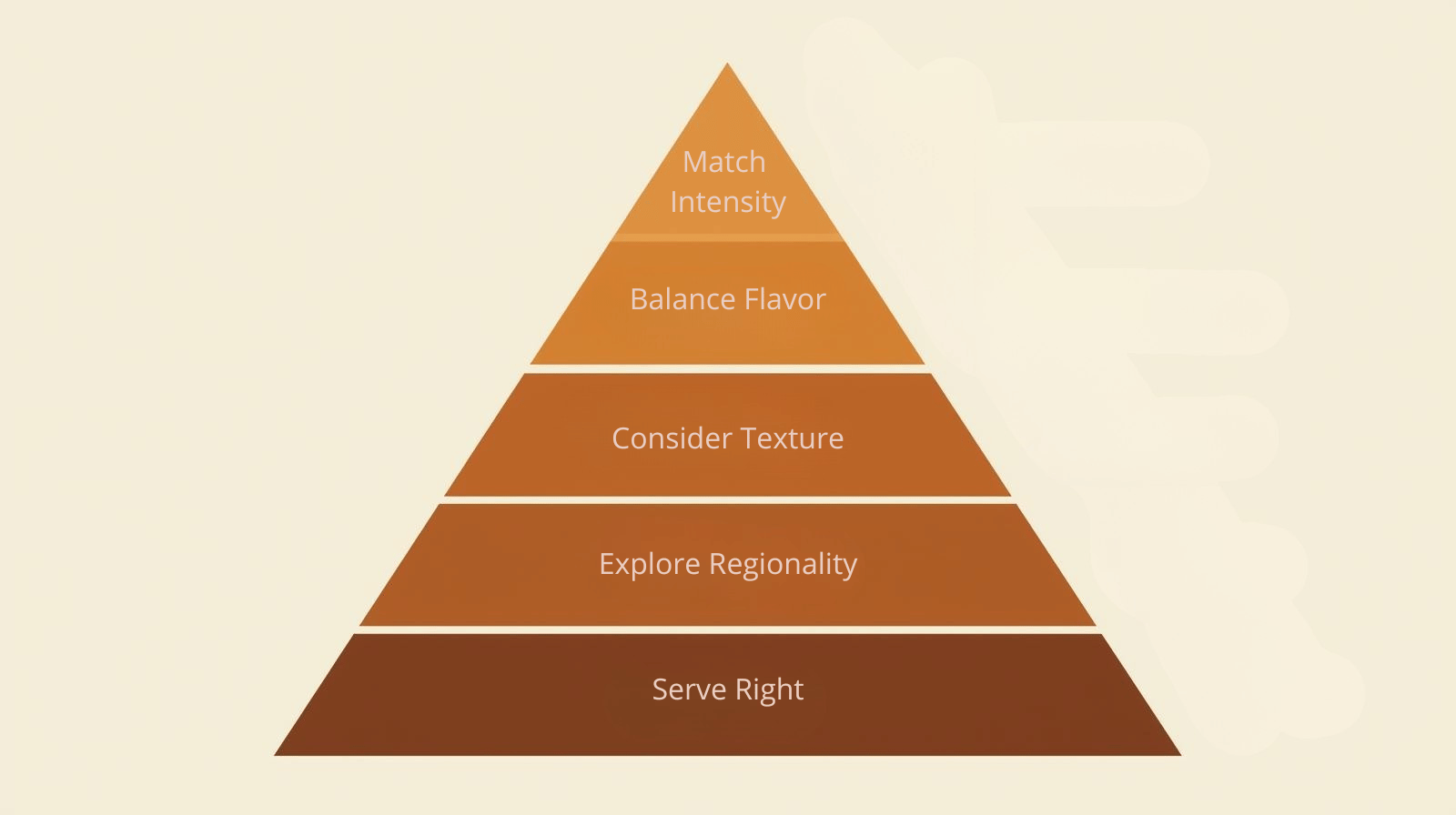
1️⃣ Match Intensity: Bold Meets Bold, Light Meets Light
The first rule is simple: never let one dominate the other.
A delicate beer like a pilsner can be crushed under the weight of a sharp blue cheese, while an imperial stout will overwhelm a mild fresh chèvre.
- Light beers (pilsner, wheat, kölsch) → soft or fresh cheeses
- Medium beers (amber, saison, pale ale) → semi-firm cheeses
- Strong beers (porter, stout, barleywine) → aged or pungent cheeses
Think of it as a conversation — not a shouting match.
2️⃣ Balance Flavor Profiles: Contrast Creates Harmony
The best pairings play with contrast: sweetness softens salt, bitterness balances richness, acidity brightens fat.
Here’s how to think about it:
- Sweet malt complements salty cheese (e.g., amber ale + Gouda).
- Hoppy bitterness cuts creamy texture (e.g., IPA + Brie).
- Tart acidity highlights tangy cheese (e.g., Sour Ale + Feta).
- Roasted malt mirrors nutty or smoky cheese (e.g., Porter + Smoked Scamorza).
When in doubt, start with opposites — then refine to find the balance that feels most natural to your palate.
3️⃣ Consider Texture and Mouthfeel
Texture can make or break a pairing. Beer’s carbonation and bubbles act like a palate cleanser, cutting through fat and coating your tongue with new flavors each sip.
For example:
- Creamy cheese (Brie, Camembert) pairs beautifully with effervescent saisons or wheat beers.
- Dense, firm cheese (Aged Cheddar, Gruyère) benefits from a malty backbone like amber or brown ales.
- Crumbly, salty cheeses (Feta, Stilton) love a contrast — something fruity or slightly sweet to smooth the edges.
Carbonation also enhances aroma, allowing subtle notes of spice, fruit, or nuts in the cheese to shine.
4️⃣ Explore Regional Pairings: Local Knows Best
One of the simplest (and most rewarding) ways to find the perfect match is to look at geography.
Local beers and cheeses often evolved side by side, shaped by the same climate, pastures, and fermentation cultures.
- Germany: Hefeweizen + Bavarian Obatzda
- Belgium: Trappist Dubbel + Chimay cheese
- England: Brown Ale + Stilton
- Czech Republic: Pilsner + Olomouc tvarůžky (aged curd cheese)
These regional affinities work because both products share the same terroir — the invisible fingerprint of place.
5️⃣ Serving Temperature & Presentation
Even the best pairings can fall flat if served incorrectly.
- Cheese: Remove from fridge 30–60 minutes before serving to bring out aroma and texture.
- Beer: Serve according to style — lagers around 6°C, ales around 10°C, stouts up to 13°C.
- Presentation tip: Start light and fresh, progress to dark and strong. Arrange clockwise on a wooden board for visual appeal and tasting flow.
For an immersive tasting, alternate sips and bites — letting each combination evolve on the palate.
🧀 Beer & Cheese Pairing Cheat Sheet
| Beer Style | Cheese Type | Why It Works |
|---|---|---|
| Hefeweizen | Fresh Goat Cheese | Light acidity complements tang and creaminess |
| Stout | Aged Cheddar | Roasted malt balances sharp umami |
| Saison | Brie or Camembert | Effervescence cuts through rich, buttery texture |
| Amber Ale | Gouda | Sweet malt mirrors toffee-like notes |
| IPA | Blue Cheese | Bitterness tames salt and amplifies aroma |
When you start applying these simple principles — intensity, texture, balance, and place — you’ll realize there’s no single “right” pairing, only combinations that feel perfectly in tune. And when the harmony clicks, that moment where hops meet cream and malt meets salt becomes unforgettable.
The 10 Perfect Cheese and Beer Pairings for 2025
Beer and cheese share an unspoken chemistry — the malt’s sweetness, the hop’s bitterness, the cheese’s salt, and the fat that rounds it all together. Whether you’re hosting a tasting night or experimenting with your homebrew, these 10 combinations prove why this timeless duo remains unbeatable in 2025.
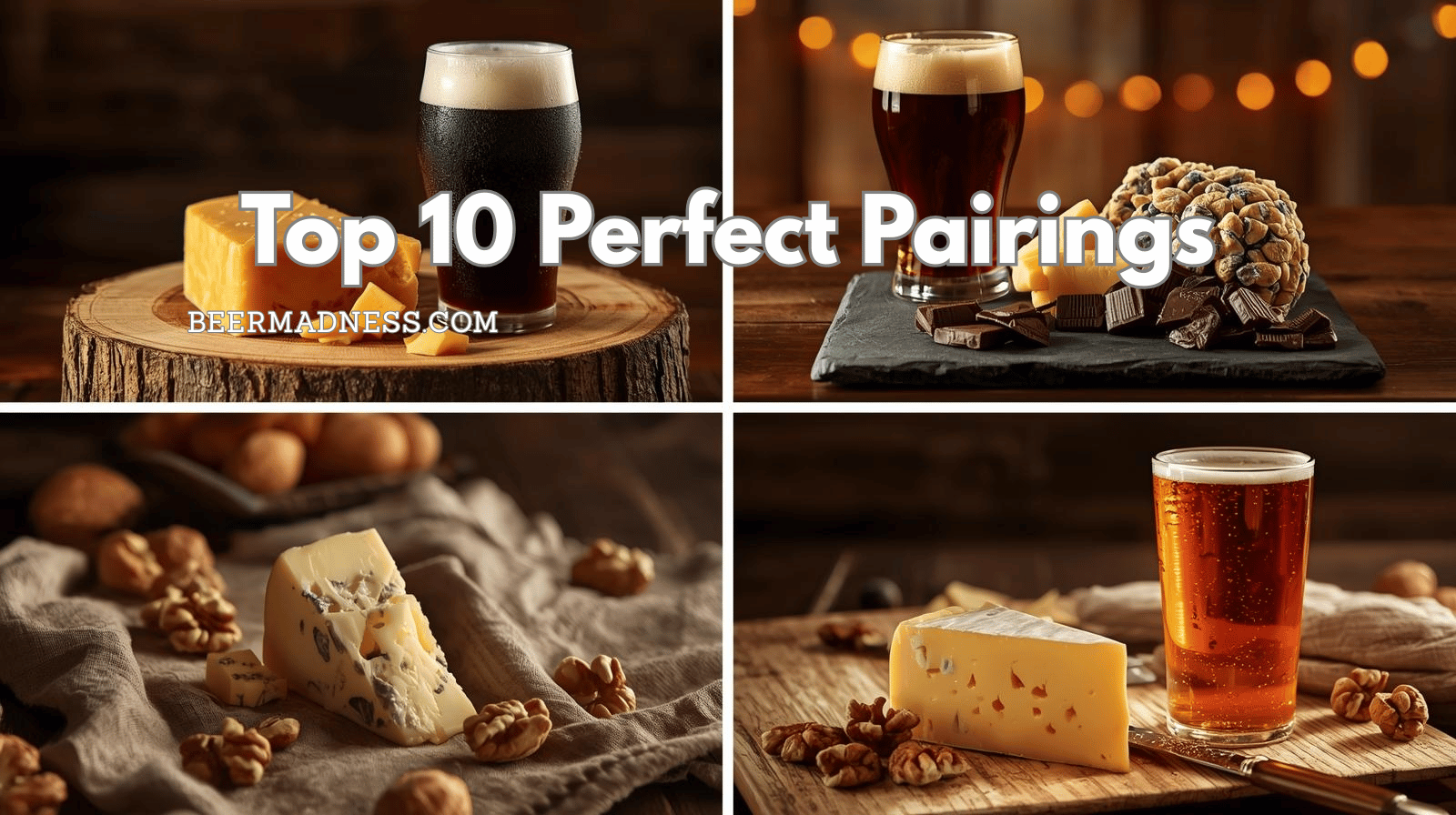
1️⃣ IPA + Aged Cheddar
The bold hop profile of an IPA — bright citrus, pine, and resin — finds its equal in a crumbly, mature cheddar.
Cheddar’s sharpness enhances the caramel notes of malt, while the hop bitterness cuts cleanly through the richness, leaving a satisfying dry finish.
Why it works: Hop bitterness meets savory umami — a perfect push-and-pull of strength and sharpness.
Try it with: English-style IPA or West Coast IPA.
Craft Beer & Brewing – IPA Style Guide
2️⃣ Wheat Beer + Fresh Goat Cheese
Soft, tangy goat cheese is naturally refreshing — and a hazy wheat beer amplifies that brightness.
The beer’s gentle carbonation and notes of banana, clove, or citrus balance the cheese’s lactic tang, creating a pairing that feels like spring in a glass.
Why it works: Acidity meets sweetness; cream meets effervescence.
Try it with: German Hefeweizen or American Wheat Ale.
Brewers Association – Wheat Beer Styles
3️⃣ Stout + Blue Cheese
Dark, roasted, and complex — a stout’s flavors of cocoa, coffee, and molasses find an unlikely friend in the pungent, salty intensity of blue cheese.
The creaminess of the cheese smooths out the stout’s roast bitterness, while the beer’s sweetness softens the blue’s bite.
Why it works: Sweet malt tones tame the salt and funk of blue cheese for a luxurious, lingering pairing.
Try it with: Oatmeal Stout or Milk Stout.
Serious Eats – Beer and Cheese Pairing Guide
4️⃣ Pilsner + Swiss (Emmental)
Clean, crisp, and bready — pilsner is one of the most underrated beer partners for cheese.
Its light malt body and subtle bitterness highlight the gentle nuttiness of Swiss cheese without overpowering it.
Why it works: Both share mellow sweetness and light complexity — the definition of balance.
Try it with: Classic Czech Pilsner or German Pils.
The Beer Connoisseur – Pilsner Styles
5️⃣ Saison + Brie or Camembert
Rustic and effervescent, saison brings peppery spice and subtle fruit to the table.
Brie’s soft, buttery texture contrasts perfectly with the beer’s dry finish, while the carbonation cleanses the palate.
Why it works: Spice cuts through cream; effervescence refreshes after each bite.
Try it with: Belgian-style Saison or Farmhouse Ale.
Belgian Beer World – Farmhouse Brewing Traditions
6️⃣ Amber Ale + Gouda
Amber ale’s caramel malt base and mild hop bitterness mirror the nutty sweetness of Gouda.
When paired with an aged variety, the combination creates a toffee-meets-umami harmony that lingers beautifully.
Why it works: Matching richness — the caramel of malt and the butterscotch note of aged Gouda.
Try it with: American Amber or Irish Red Ale.
BBC Good Food – Cheese Pairing Tips
7️⃣ Porter + Smoked Cheese (Scamorza or Applewood)
Porter’s roasted malt and hints of chocolate or coffee love the smoky, savory notes of smoked cheeses.
Each sip resets the palate while amplifying the cheese’s campfire-like flavor.
Why it works: Smoke and roast echo each other — deep, cozy, and comforting.
Try it with: Robust Porter or Baltic Porter.
CraftBeer.com – Porter Style Profile
8️⃣ Belgian Dubbel + Washed-Rind Cheese (Taleggio, Munster)
Funky meets funky.
A Belgian Dubbel’s dark fruit esters and caramelized malt sweetness complement the pungent aroma and creamy bite of washed-rind cheeses like Taleggio or Munster.
Why it works: Shared complexity — both rustic, yeasty, and richly layered.
Try it with: Trappist Dubbel or Abbey Ale.
BeerAdvocate – Belgian Dubbel Profile
9️⃣ Sour Ale + Feta or Halloumi
Bright, acidic, and refreshing, sour ales like Berliner Weisse or Gose are ideal for lighter, briny cheeses.
The beer’s tartness elevates the cheese’s saltiness, while any fruity notes (raspberry, lemon, coriander) add a playful edge.
Why it works: Acidity cuts salt; fruit enhances freshness.
Try it with: Gose or Fruited Berliner Weisse.
Lambic.info – Sour Beer Styles
🔟 Barleywine + Stilton or Roquefort
For the grand finale, few pairings rival the indulgence of a full-bodied barleywine with a rich, pungent blue like Stilton or Roquefort.
The beer’s toffee sweetness and warming alcohol harmonize with the cheese’s creamy salt, creating a dessert-worthy finish.
Why it works: Sweet meets savory in a luxurious, slow-sipping crescendo.
Try it with: English Barleywine or American Strong Ale.
The Beer Connoisseur – Barleywine Styles
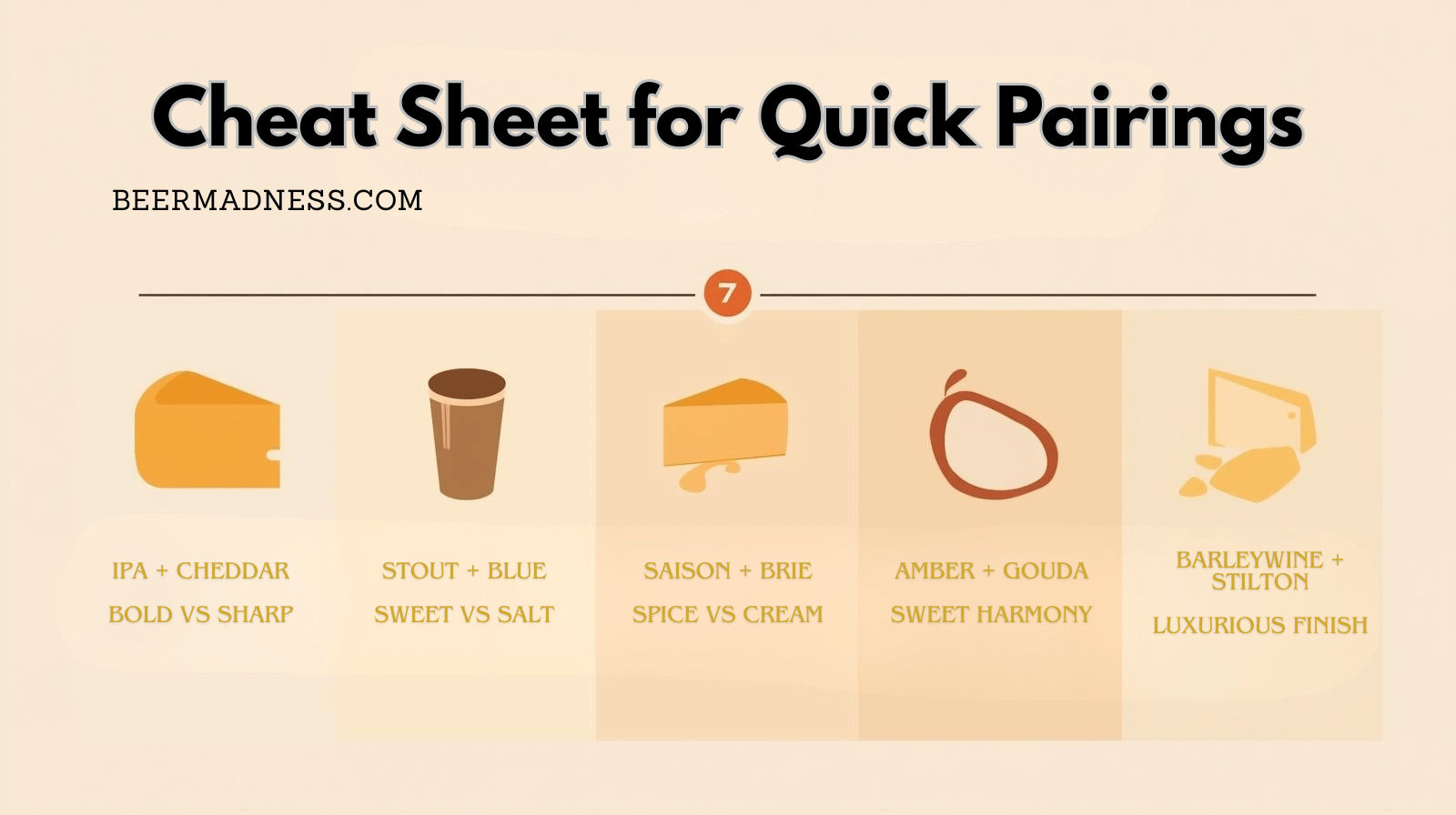
Each of these Perfect Cheese and Beer Pairings tells its own story — of contrast, balance, and craftsmanship. Together, they form a tasting journey through malt, milk, and time — proof that when artisans work with nature, harmony is never far away.
🍺 Taste & Travel Like a Beer Pro
Love what you’re reading? Turn inspiration into your next beer adventure:
- 🛒 Beers of Europe – shop iconic craft selections & limited editions
- 🏨 Hotels.com – find cozy stays near top beer festivals
- 🎟️ Viator – join brewery tours & tasting experiences
Plan • Sip • Repeat — your next beer trip starts here.
Hosting a Beer and Cheese Night
There’s something timeless about sharing good beer and good cheese with friends. The laughter, the clinking glasses, the discovery of new flavors — it all feels as natural as the fermentation that made it possible. Hosting a beer and cheese night at home doesn’t require a sommelier’s skills — just curiosity, balance, and a few smart details.
Think of it as a celebration of craft — two simple ingredients (milk and grain) transformed into endless possibilities.
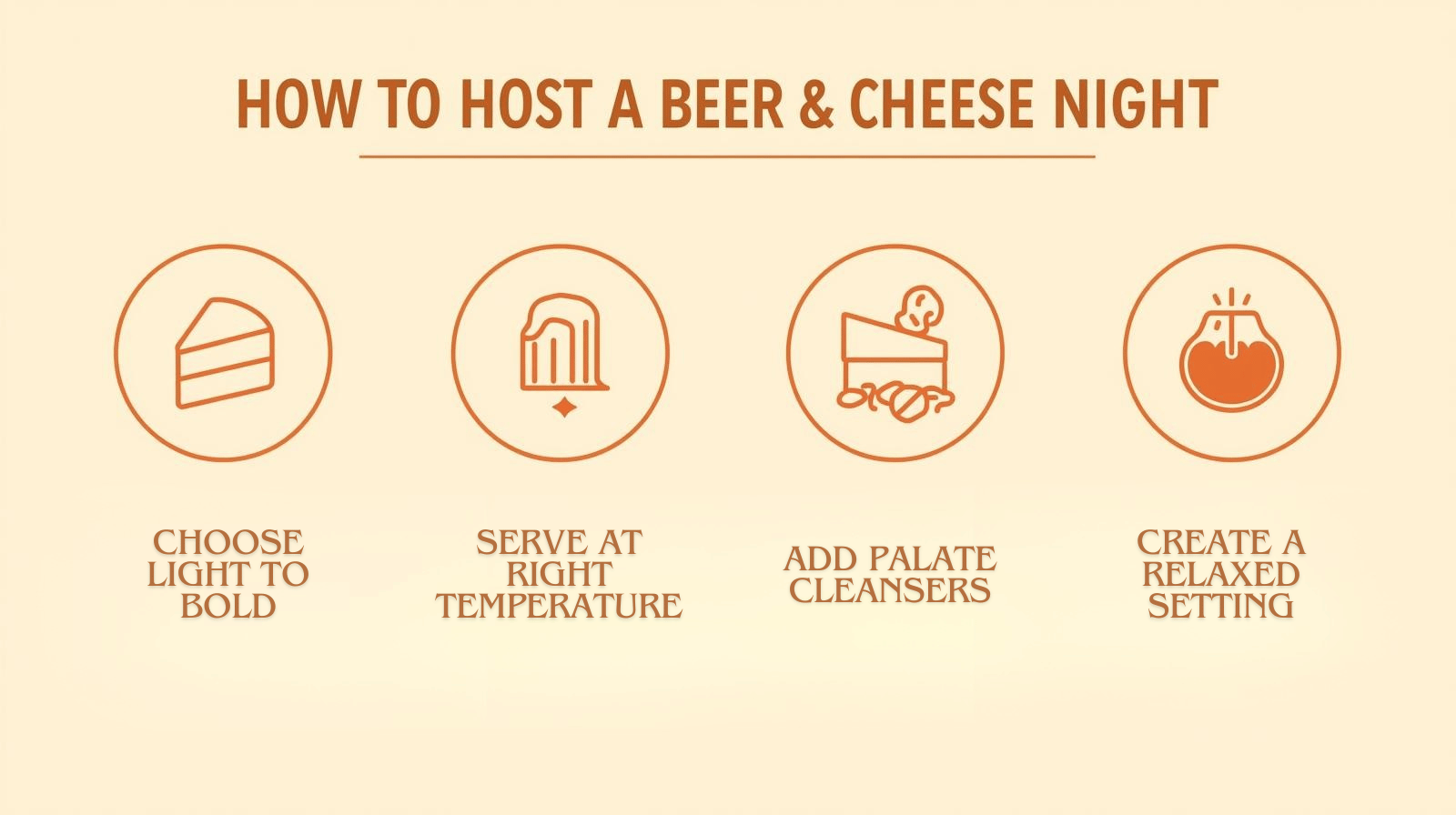
1️⃣ Setting the Stage: Create a Flavor Journey
The key to a successful tasting is progression — guiding your guests from light and delicate to dark and bold.
Just as you would in a beer flight, build the experience gradually so that no flavor overwhelms the next.
Start with:
- Fresh or soft cheeses (mozzarella, goat cheese, brie)
- Paired with lighter beers (pilsner, wheat, saison)
Move toward:
- Aged, washed-rind, or blue cheeses
- With stronger, maltier beers (amber, porter, barleywine)
This sequencing keeps the palate awake and the experience layered. According to CraftBeer.com’s tasting guide — an excellent resource for sensory exploration — contrasting light and heavy flavors allows each combination to stand out instead of blending into one note.
2️⃣ Presentation: Make It Inviting and Balanced
A tasting board is as much about beauty as it is about balance.
Use a large wooden board or slate, and place your cheeses in order from mild to strong (clockwise is easiest). Between each, add texture and contrast:
- Slices of rustic bread or crackers for crunch
- Dried fruit and nuts to highlight sweetness
- Small bowls of honey or chutney for pairing play
Label each cheese and beer — even just with handwritten tags — so guests can revisit their favorites. As the BBC Good Food editors suggest, visual cues make the tasting more approachable, especially for newcomers who might not know a gouda from a gruyère.
3️⃣ Temperature and Timing Matter
Temperature can make or break your perfect cheese and beer pairings.
- Cheese: Always serve at room temperature — cold cheese tastes muted and hard. Take it out of the fridge at least 30–60 minutes before tasting.
- Beer: Chill by style. Serve lagers around 6°C, pale ales near 8°C, and darker beers like stouts or barleywines closer to 12–13°C.
As noted by The Brewers Association, serving beer too cold suppresses its aroma, while letting it breathe brings forward malt sweetness, fruit esters, and hop nuance — all crucial for pairing harmony.
4️⃣ Palate Cleansers: The Unsung Heroes
A good palate cleanser keeps each bite and sip feeling fresh.
Skip heavily flavored snacks like chips or olives — they interfere with delicate aromas. Instead, use:
- Plain crackers or baguette slices
- Crisp apple or pear slices
- Sparkling water between heavier pairings
For ambitious hosts, include a small bowl of nuts or roasted barley for a sensory twist — it ties the tasting back to beer’s origins. According to Serious Eats, neutral palate cleansers preserve the natural contrast between pairings, which is essential for recognizing subtle flavor shifts.
5️⃣ How to Guide the Tasting
Invite your guests to slow down — this isn’t just about eating and drinking; it’s about noticing.
Encourage them to take three steps for each pairing:
- Smell both beer and cheese separately.
- Taste the cheese first, then take a small sip of beer.
- Notice how the flavors merge, fade, or intensify.
Offer conversation starters like:
- “Does the beer make the cheese taste sweeter?”
- “What’s the texture like after you sip?”
- “Would this pairing work better reversed?”
By the end, your table will sound like a flavor lab — and that’s the beauty of it.
6️⃣ A Toast to Shared Craft
Hosting a beer and cheese night isn’t about perfection; it’s about discovery. The joy lies in those moments when you find a pairing that surprises you — when the bubbles lift the cream, or the salt deepens the sweetness.
Whether you’re tasting with friends or testing your homebrew, every pairing tells a story — of farmers, brewers, and time itself.
So gather your favorite people, your best cheeses, and a mix of bottles, and see where flavor takes you.
Bonus for Homebrewers: Pairing with Your Own Beer
There’s a special thrill in tasting your own homebrew beside a perfectly chosen cheese — because in that moment, you’re not just drinking beer; you’re tasting your craft.
For homebrewers, pairing offers a chance to study flavor balance with precision. Malt sweetness, hop bitterness, and carbonation aren’t just recipe notes — they’re tools to build harmony with different cheese textures and intensities.
1️⃣ Start with a Flavor Baseline
Before you think about the perfect cheese and beer pairings, take a sensory snapshot of your brew:
- Sweetness: Derived from malt — does it lean toward caramel, honey, or toast?
- Bitterness: How sharp or floral is it? Does it linger or fade quickly?
- Body: Light and crisp, or thick and creamy?
- Carbonation: Fine and sparkling or soft and velvety?
Pour a small tasting glass and write down what you taste. Then choose a cheese that naturally contrasts or mirrors those traits.
For example:
- A malty, low-bitterness brown ale pairs beautifully with nutty Alpine cheese.
- A bitter, resinous IPA cuts through creamy cheddar or brie.
- A soft, effervescent saison brings freshness to buttery textures.
Homebrewers Association – Flavor Evaluation Guide
2️⃣ Adjusting Malt Sweetness
If your beer feels too dry or harsh next to a cheese, increase malt sweetness in your next batch.
Use caramel or Munich malts for richness that complements salty or aged cheeses. Conversely, if the pairing feels cloying, dial sweetness back with a drier yeast strain or a touch more bitterness.
As the Brewers Association notes, sweetness acts like seasoning — it can round sharp flavors and soften bitterness when used in balance.
3️⃣ Managing Bitterness and Hop Intensity
Hops are both your ally and your challenge.
A pairing that tastes stunning with a citrus-forward pale ale might collapse under a double IPA’s bitterness.
Homebrewer’s tip:
- Pair bitter beers with salty or fatty cheeses (cheddar, gouda, blue).
- Pair low-bitterness beers with delicate, fresh cheeses (mozzarella, goat).
- For experiments, brew two versions of the same recipe — one at 25 IBU, another at 45 IBU — and taste how pairing dynamics change.
Craft Beer & Brewing – Hop Flavor Science
4️⃣ Fine-Tuning Carbonation
Carbonation is your secret weapon in cheese pairings.
Too much fizz can overpower creamier cheeses; too little can make the experience feel heavy.
If your homebrew’s mouthfeel feels “flat” beside rich cheeses, slightly increase priming sugar at bottling or boost CO₂ pressure in keg conditioning.
Higher carbonation brightens acidity and cuts through fat, while softer bubbles preserve creaminess.
BYO – Carbonation Techniques for Homebrewers
5️⃣ Record, Refine, Repeat
Keep a simple pairing journal — your own Beer & Cheese Log.
For each test, note:
- Beer style and recipe
- Cheese type
- First impression
- Flavor balance (sweet, salty, bitter, creamy)
- Adjustments for next brew
Over time, you’ll start seeing patterns — how your yeast strain enhances certain textures, or how small malt shifts change pairability.
As CraftBeer.com points out, sensory tracking is what turns casual tasting into true craftsmanship.
6️⃣ Your Own Signature Pairing
Every homebrewer eventually creates one pairing that feels like their fingerprint — the one that no store or bar can replicate.
Maybe it’s your amber ale with aged Swiss, or your citrusy pale ale with grilled halloumi.
Brewing gives you control. Pairing gives you purpose.
Together, they turn your beer from something you drink into something you share.
So next time you bottle your latest batch, grab a wedge of cheese and a notepad — and see what new story your beer wants to tell.
FAQ: Everything You Need to Know About Cheese & Beer Pairing
What makes beer and cheese such a perfect match?
Beer and cheese pair perfectly because carbonation, malt sweetness, and hop bitterness balance the fat, salt, and acidity in cheese, creating harmony through contrast.
How should I serve beer and cheese together?
Bring cheeses to room temperature (about 18 °C / 64 °F) and serve beers at style-appropriate temperatures: 6 °C for lagers, 10 °C for ales, 12–13 °C for stouts.
Pour small beer samples (100 ml) so aromas open up without warming too fast.
What’s the best order for a cheese and beer tasting?
Start light, finish bold.
Move from mild → aged → smoked → blue cheeses while increasing beer intensity from pilsner to barleywine.
This sequence lets each pairing shine without fatigue.
Can I prepare cheese boards in advance?
Yes — slice or cube cheeses an hour ahead, cover loosely with parchment, and store at a cool room temperature.
Avoid plastic wrap, which traps moisture and dulls aroma.
Add bread, fruit, or nuts right before serving for texture contrast.
How long do leftovers last after a pairing night?
Wrap leftover cheese in wax or parchment paper, then refrigerate inside a breathable container for up to a week.
Let it warm slightly before reusing.
Open beer bottles lose carbonation quickly, but corked or resealed growlers can hold freshness for 24–48 hours.
Can non-alcoholic or low-ABV beers pair with cheese?
Absolutely. Their gentler carbonation and malt sweetness make them perfect for lighter cheeses like brie, chèvre, or young gouda.
The flavor balance remains — only the buzz disappears.
Beer and cheese remind us that great craftsmanship doesn’t demand complexity — only care.
When you taste them side by side, you’re not just sampling food; you’re exploring the meeting point between grain and milk, brewer and cheesemaker, chemistry and art.
2025’s Perfect Cheese and Beer Pairings prove one thing: the old rules are fading, and flavor is your only limit. Whether you prefer a farmhouse saison with brie, a stout with Stilton, or your own homebrew beside local cheddar, every pour tells a story of balance and imagination.
Ready to keep tasting?
🍻 More from BeerMadness
- 👉 Top 10 Beers to Pair with Chocolate
- 🔥 BBQ and Beer Pairing: The Ultimate 2025 Guide
- 🌍 10 Best Oktoberfest Alternatives in Europe
Keep exploring the world of craft beer — one pour at a time.
Raise your glass, slice the cheese, and toast to the union of patience, passion, and the pure joy of discovery.

